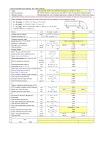Net positive suction head is the term that is usually used to describe the absolute pressure of a fluid at the inlet to a pump minus the vapour pressure of the liquid. The resultant value is known as the Net Positive Suction Head available. The term is normally shortened to the acronym NPSHa, the "a" denotes available.
Net Positive Suction Head Available( NPSHa) :
The amount of NPSH available to the pump from the suction line is termed NPSHa. And also NPSHa is defined as:
NPSHa = Pressure head + Static head – Vapor pressure head of your product – Friction head loss in the piping, valves and fittings.
A similar term is used by pump manufactures to describe the energy losses that occur within many pumps as the fluid volume is allowed to expand within the pump body. This energy loss is expressed as a head of fluid and is described as NPSHr (Net Positive Suction Head requirement) the "r" suffix is used to denote the value is a requirement.
The amount of NPSH the pump requires to avoid cavitation is called NPSHr. NPSH required is a function of the pump design and is determined based on actual pump test by the vendor.
Different pumps will have different NPSH requirements dependent on the impellor design, impellor diameter, inlet type, flow rate, pump speed and other factors. A pump performance curve will usually include a NPSH requirement graph expressed in metres or feet head so that the NPSHr for the operating condition can be established.
Pressure head refers to absolute pressure on the surface of the liquid reservoir supplying the pump suction, converted to feet of head or meter of head. If the system is open, hp equals atmospheric pressure head.
Static Suction Head (hS) :
Head resulting from elevation of the liquid relative to the pump center line. If the liquid level is above pump center line, hS is positive. If the liquid level is below pump center line, hS is negative. Negative hS condition is commonly denoted as a “suction lift” condition.
Vapour Pressure Head (hvp):
The vapour pressure of liquid can be obtained from vapour pressure tables. When the vapour pressure is converted to head, it is referred to as vapor pressure head, hvp. The value of hvp of a liquid increases with the rising temperature and in effect, opposes the pressure on the liquid surface, the positive force that tends to cause liquid flow into the pump suction i.e. it reduces the suction pressure head.
Friction Head (hf):
The head required to overcome the resistance to flow in the pipe and fittings. It is dependent upon the size, condition and type of pipe, number and type of pipe fittings, flow rate, and nature of the liquid.
The head required to overcome the resistance to flow in the pipe and fittings. It is dependent upon the size, condition and type of pipe, number and type of pipe fittings, flow rate, and nature of the liquid.
Comparison of NPSHa and NPSHr :
All calculated values must be in the same units either meter head or feet head. If the NPSHa is greater than the NPSHr cavitation should not occur. If the NPSHa is lower than the NPSHr then gas bubbles will form in the fluid and caviation will occur.
Increasing the NPSH available :
To increase the NPSHa consider the following:
- Increase the suction pipe work size to give a fluid velocity of about 1 m/sec or 3 ft/sec
- Redesign the suction pipe work to eliminate bends, valves and fittings where possible.
- Raise the height of the fluid container.
- Pressurized the fluid container, but ensure that the pressure in the container is maintained as the fluid level is lowered.
Cavitation:
Liquid entering the impeller eye turns and is split into separate streams by the leading edges of the impeller vanes, an action which locally drops the pressure below that in the inlet pipe to the pump. If the incoming liquid is at a pressure with insufficient margin above its vapour pressure, then vapour cavities or bubbles appear along the impeller vanes just behind the inlet edges.
This Phenomenon is known as cavitation and has three undesirable effects:
- The collapsing cavitation bubbles can erode the vane surface, especially when pumping water-based liquids.
- Noise and vibration are increased, with possible shortened seal and bearing life.
- The cavity areas will initially partially choke the impeller passages and reduce the pump performance. In extreme cases, total loss of pump developed head occurs.
Avoiding cavitation :
In a system where the pipe work layout provides a positive head, the motive force to move the fluid to the pump will be the fluid surface pressure plus the positive head. Incorrect sizing of the supply pipe work and isolating valves may result in high frictional losses which can still lead to situations where the NPSHa is still too low to prevent cavitation.













-page-001.jpg)

0 Comments